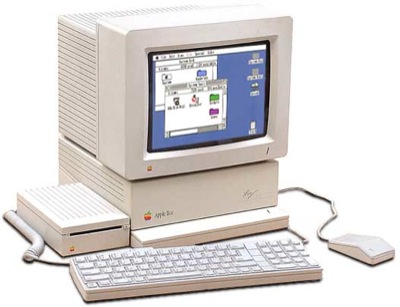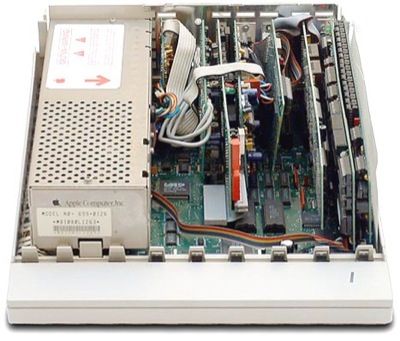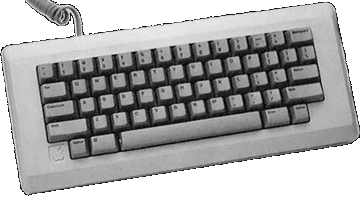Apple //gs

Essentials
Family: Pre-Macintosh
Codename: Cortland, Phoenix, Rambo, Gumby, Tenspeed, Blockbuster
Introduced: September 1986
Terminated: December 1992
Processor
CPU: Western Design Center 65C816
CPU Speed: 2.8 MHz
FPU: integrated
Bus Speed: 1 MHz
Register Width: 16-bit
Data Bus Width: 16-bit
Address Bus Width: 16-bit
ROM: 128/256 kB
Onboard RAM: 256 kB
Maximum RAM: 8 MB
Video
Max Resolution: 2 bit 640x200, 4 bit 320x200
Video Out: DB-15
Storage
Floppy Drive: 5.25" Disk ][ or 3.5" Sony 800 kB, via floppy port
Input/Output
ADB: 1
Floppy: DB-19
Joystick/Mouse: DE-9
Serial: 2 Mini DIN-8
SCSI: via expansion card
Audio Out: mono mini
Speaker: mono
Miscellaneous
Power: 60 Watts
Dimensions: 4.6" H x 11.2" W x 13.7" D
Weight: 8.72 lbs.

The last member of the Apple // line, The Apple //gs was a also the most powerful. Announced in September 1986, the IIgs was built around a Western Design Center 65C816 processor running at either 2.8 or 1 MHz. It included expanded graphics and sound functions, and was initially offered with 256 kB of RAM, expandable to 8 MB. The IIgs also offered 128 kB of ROM, expandable to 1 MB. The //gs shipped with a Mac-like interface and a //gs-specific OS, and introduced the Apple Desktop Bus (ADB) port. (It also ran most other Apple // software.) The //gs was the first computer to include a Large Scale Integration (LSI) chip, designed by Steve Wozniak, and called the IWM (Integrated Woz Machine). The //gs was later offered with 1 MB of RAM, and 256 kB of ROM. It could also hold a SCSI adapter card, and was discontinued in December of 1992. Many 3rd party refinements and expansions have been offered for the Apple //gs (including processor upgrades up to 18 MHz), and there is still a fairly large installed base.
Picture Credits:
Old Computers
Date: Thu, 02 Nov 2000 23:11:00 -0800
From: Mitchell Spector
Subject: Apple IIGS correction
>Sound Output: built in speaker
It offered much more than that. Each machine had a built-in Ensoniq 5503 Digital Oscillator, a music synthesizer chip capable of wavetable synthesis. There was 64 kB of dedicated RAM (separate from main RAM) to load waveform patches into. The chip had an 8-bit sound resolution and could do stereo output and record sound with it's ADC, but Apple only shipped the machine with a 1/8" *mono* headphone jack. You had to purchase third party hardware to demultiplex the stereo signal already there and input sound.
The chip had 32-oscillators, meaning it was capable of 32 voices! The GS firmware paired the voices (and reserved two for timings) to come up with 15 voices as standard. Up until the early to mid 90's, it was the most powerful home computer in existance for music and sound capabilities (most certain more advanced than what the Amiga and Macintosh offered).
Date: Tue, 02 Aug 2005 19:08:56 -0700
From: Antonio Rodríguez
Subject: Apple //gs
The Apple //gs could display an enhanced 320x200 video mode with up to 3200 colors (16 unique colors in each of the 200 scan lines). As far as I know, it was the only computer of that era capable of displaying more than 256 colors.
The //gs' video port is a DB-15. It's funny: Apple has used three different DB-15 video connectors (Apple //c video expansion port, Apple //gs video output port, and Macintosh II analogue video output), and all three of them were completely incompatible between them. In fact, plugging a //gs monitor into the //c's video port could fry the //c's motherboard.
The //gs was not the first computer using the IWM chip - it has been already used in the Macintosh, the //c and the Unidisk 3.5" controller card for the //+ and //e. It wasn'tdesigned by Woz, either - it only was based on Woz's Disk ][ controller.
Strangely, the //gs had a stereo-capable sound chip but a mono sound output. There were third-party boards that enabled the //gs to generate stereo sound... without adding an extra sound chip!
Date: Thu, 22 Nov 2007 02:14:53 -0800
From: Ben Harper
Subject: Apple IIgs notes
It is worth noting that the Apple //gs's "Mac-like interface and a //gs-specific OS" was actually called "GS/OS".
Another significant feature was that it had a special sound chip made by a company called Ensoniq which made 8 bit sound about as good as 16 bit. The sound chip could run entirely on its own using wave tables, essentially similar to a professional keyboard with sound samples triggered by a musical score by which it could be instructed to play them. You could be playing a game, crash the computer and the soundtrack would continue indefinitely.
Other notes were that in low res mode, it could display up to 3200 colors on the screen, but only 16 colors per scanline. The 3200 colors were out of a total of 4096. There were eventually some color conversion programs that could convert true-color to 3200 colors with very little artifacts, and it looked a lot better than the 8-bit color which was available on PC's at the time. Unfortunately, by the time everyone discovered that it could display 3200 colors and by the time programs came out to convert to that format, PC's and Mac's already had 16 or 24-bit. In high res mode, you had 4 colors: black, white, orange and green. If you put an orange pixel next to a green one, it would turn purple, black next to white made grey, etc. You had less than 8 colors total to choose from. High-res mode was hardly used because of its odd color behavior.
There were about 1000 Apple IIgs's that were released as "Woz Special Editions" which meant that they had the Woz's signature on the front of the case. I still have one of the cases somewhere in my garage but it has no motherboard. If I ever dig it up I'll send you a picture. ;)
Date: Fri, 12 Dec 2008 10:20:31 -0800
From: Tahrey
Subject: comments on IIgs page
"The Apple //gs could display an enhanced 320x200 video mode with up to 3200 colors (16 unique colors in each of the 200 scan lines). As far as I know, it was the only computer of that era capable of displaying more than 256 colors"
Sorry Rodriguez... even at the time the IIgs was released, there were computers with better graphical capabilities around. In fact if they weren't, Apple might not have bothered improving it as much as they did.
Just for two examples, the Atari ST could do the same pallete-switching trick without much difficulty (though it wasn't a "standard" mode), and do it 3 times *per line* (the advantage of having an 8Mhz CPU) so you could have a max of 48, or realistically 30-40 colours per line from it's pallete of 512, thereby displaying the entire 9-bit pallete on screen at once (or 3000-ish with a bit of subtle 30Hz flicker by switching a colour between the two closest shades with every scan). Not exactly 3200, but good enough, and having more colours per line is more beneficial I'd argue. The STe revision in the late 80s pushed that out to a max pallete of 4096 (12bit) which you could again show all of across one screen, or nearly 20000 with the colour flicker trick.
And of course there was the Amiga that had a 12 bit pallete from the off, had a variety of modes where you could show 32 colours onscreen at once, and presumably do the same pallete-swap tricks as the ST; unfortunately I was in the atari camp so I'm not privy to those details. But I do know, of course, of the legendary HAM mode, which sacrificed a little horizontal clarity for the ability to display full-range pictures with no special tricks at all (changing one of the colour channels per pixel; so it was only really, say, 213 pixels horizontal rez if it was a 640x200 HAM mode, but that's still pretty good for a 1980s attempt at "true colour").
Also the Japanese Phillips X68000 allegedly had a 32000 colour mode, and that predated all three machines. I think it must have been very expensive, however.
